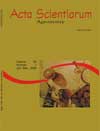Relative heterosis in common bean (<em>Phaseolus vulgaris</em> L.)
Abstract
The characteristic mean number of days to emergence, number of days to flowering, mean height of the first pod insertion, mean longitudinal length of pods, mean final plant height, total number of pods per plant, mean number of seeds per plant, mean number of seeds per pod, mean seed weight and grain yield were assessed to estimate the heterosis of hybrids in relation to the parental means. Six common bean cultivars Phaseolus vulgaris L. and their 15 possible diallel hybrids were assessed in a complete block randomized design with ten replications at the Center of Agricultural Research - CAR, of Universidade Estadual de Maringá, Maringá, State of Paraná, Brazil, in 1997. As for the potentiality for shorter plant emergence and flowering period, the distinguishing combinations were LPSPI 93-17 x FT-Nobre and LPSPI 93-19 x FT-Nobre. As for grain yield, no negative heterotic manifestation occurred, thus indicating that the recombinations obtained may generate superior segregant genotypes. Regarding the grain yield, the highest heterotic values were found in LPSPI 93-19 x Rudá, LIPSPI 93-17 x FT-Nobre, Rudá x Campeão-1, FT-Nobre x Aporé and LIPSPI 93-17 x Aporé combinations with the respective following values: 23.13%, 17.37%, 16.67%, 15.38% and 14.91%, thus leading to the conclusion that precocious and more productive genotypes can be derived from segregant generations.Downloads
Download data is not yet available.
Published
2008-07-14
How to Cite
Barelli, M. A. A., Vidigal, M. C. G., Amaral Júnior, A. T. do, Vidigal Filho, P. S., & Scapim, C. A. (2008). Relative heterosis in common bean (<em>Phaseolus vulgaris</em> L.). Acta Scientiarum. Agronomy, 20, 257-262. https://doi.org/10.4025/actasciagron.v20i0.4353
Issue
Section
Agronomy
DECLARATION OF ORIGINALITY AND COPYRIGHTS
I Declare that current article is original and has not been submitted for publication, in part or in whole, to any other national or international journal.
The copyrights belong exclusively to the authors. Published content is licensed under Creative Commons Attribution 4.0 (CC BY 4.0) guidelines, which allows sharing (copy and distribution of the material in any medium or format) and adaptation (remix, transform, and build upon the material) for any purpose, even commercially, under the terms of attribution.
2.0
2019CiteScore
60th percentile
Powered by 

2.0
2019CiteScore
60th percentile
Powered by 



















































